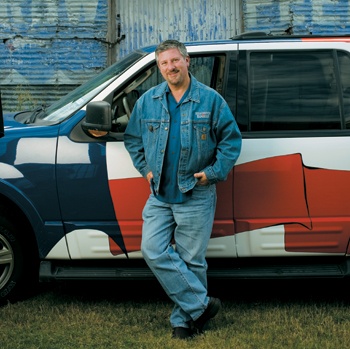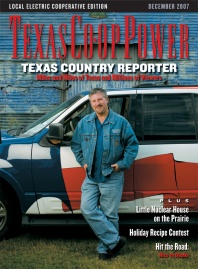Everyone’s quiet as trainer Lynn Rorke Reardon gently urges Sonny, a retired thoroughbred racehorse, to trot faster around the pen. Leaning against the metal fence, photographer Dan Stricklin balances a bulky black Betacam on his shoulder and shoots the action.
Behind him, Bob Phillips—host of television’s long-running, folksy “Texas Country Reporter”—waits to chat with Reardon about her efforts to find homes for retired Texas racehorses. Since 2003, she’s placed more than 500 horses with new owners through her adoption ranch near Austin called LOPE (short for LoneStar Outreach to Place Ex-Racers).
From inspirational people such as Reardon to offbeat stops, country cafés and even a few amazing animals, Phillips finds all kinds of stories as he explores the state’s highways and back roads. “Hop in and travel with me,” he warmly invites viewers each week as he takes off on yet another installment of “Texas Country Reporter.” On the air since 1972, Phillips so far has logged some 2 million miles and produced more than 2,700 half-hour shows.
At the moment, though, it’s his turn to distract Richie Cee, an overly friendly chestnut gelding at LOPE who insists on poking his nose into Stricklin’s camera. “You got yourself a horse there, Bob,” Reardon quips as Phillips rubs Richie’s long, brown mane.
Phillips is perfectly relaxed with the pushy horse. He’s been in front of the camera long enough to know a few things: expect the unexpected, go with the flow, and—oh, yeah—don’t ever be shy.
Guts—that’s what landed Phillips in the business in the first place. Fresh out of high school, encouraged by a journalism teacher to keep writing, the Dallas native enrolled in a local junior college in 1969. One day, Eddie Barker—the respected Dallas news anchor who announced the death of President Kennedy shortly before Walter Cronkite—visited Phillips’ journalism class.
Following the lecture, Phillips, then 18, walked up to Barker and asked him for a job at his television station. Barker gruffly agreed. “He told me later that he hired me ‘cause I had the guts to ask for a job,” Phillips recalls. “I said, no, it was ‘cause I’d needed a job!” At the CBS-affiliate station, Phillips worked his way up from gofer to news cameraman and then reporter. While still working full time, he earned his bachelor’s in journalism and broadcast-film-art, and a master’s of liberal arts at Southern Methodist University.
In 1972, he worked as photographer with “4 Country Reporter” and soon became host. Similar in format to Charles Kuralt’s popular “On the Road” series, Phillips traveled the region’s rural roads in search of unique stories.
“I did small-town features, but they had to have a newsy side, too,” he says during an off-camera break at Reardon’s horse ranch. “Gradually, though, I started asking less hard news questions. Finally, in Forney (east of Dallas), I asked two ranchers, ‘How does a cow stand up? With its front legs first or its back legs?’ Those two guys got into an argument right there. Viewers wrote in and called the station, saying how much they loved it. After that show, the bosses let me go and do whatever I wanted.”
Fun and upbeat, “4 Country Reporter” aired twice weekly until 1986, when new management canceled the show. However, the station agreed to give Phillips the program’s copyright, which allowed him to keep the same name and format. Later that year, he started Phillips Productions and syndicated “Texas Country Reporter.”
Nowadays
“Texas Country Reporter” airs on 24 Texas stations and the RFD-TV network. “Our ratings indicate that we reach 1.3 million people a week on Texas broadcast stations and a million nationwide on RFD,” Phillips says.
Unbeknownst to most viewers, a lot of behind-the-scenes work and time goes into producing just one of a half-hour show’s three stories, such as today’s visit with Reardon and her horses at LOPE.
“Typically, we don’t do a lot of research,” Phillips explains while Stricklin—along with producer Ryan Britt and production assistant Mike Synder—film Reardon riding a horse across a grassy meadow. “We’ll look at someone’s website ahead of time, but a lot of people don’t have one. So we talk to them on the phone. Viewers don’t know these other people are here spending 18 hours with one person to get a six-minute story. They think I drive around and talk to people all by myself.”
On this spring morning at LOPE, gray skies threaten overhead. Phillips just shrugs.
“We always hope for beautiful skies,” he says, “but we shoot in everything. We shoot people’s lives, and that’s sometimes in the rain.”
Annually, Phillips and his staff produce 78 stories.
“Most come from viewers,” he says. “We get hundreds of e-mails every day. We also get ideas from traveling around; people will tell us about someone else. Plus we read lots of Texas magazines and newspapers. Dan found this story [LOPE] in the Fort Worth Star-Telegram. We’re pretty blatant about reading something in a publication and then doing the story, but we give it a different twist.”
After 35 years on the road, Phillips instinctively recognizes stories worth telling.
“Lynn’s got so much passion for her horses that that makes this story,” Phillips says. “We don’t care about what they’re doing as much as why they’re doing it. If people care, it’s a good story. Our stories range from deeply moving, passionate stories about people’s lives to places where people can go to visit or eat. We do ‘ain’t that neat’ stories, too, like a cemetery in Paris, Texas, where there’s a statute of Jesus wearing cowboy boots. Oh, yeah, we got a lot of responses on that one!”
So did a story on Skidboot, a blue heeler trained and loved by Quinlin farrier David Hartwig. The dog’s amazing ability to perform intricate tricks wowed such celebrities as Oprah Winfrey, Jay Leno and David Letterman. Sadly, Skidboot died at age 14 last March. (See Phillips’ video on Skidboot online at www.youtube.com/texascountryreporter.)
Needless to say, Phillips knows Texas well. When the town of Clark changed its name to DISH, Phillips headed to North Texas and asked why (folks now have a decade’s worth of free satellite TV service). In Colleyville, he watched as Bob Wilder flew rubber-band airplanes in a school gym with his cronies. In Amarillo, he rubbed elbows with Bob Flesher, who makes (and plays) upright bass instruments from washtubs, and, in Corpus Christi, he shared a table with Bill and Lois Patillo, who serve delicious “dishes”—scrambled eggs, hamburgers, yams, key lime pie and more—made entirely from rocks.
On the personal side, Phillips, 56, says little—he’s been single since 40, no children. When not on the road or teaching at private Amberton University in Dallas, he relaxes at either his Dallas home, another in Beaumont or his Hill Country resort called Escondida (which is served by Bandera Electric Cooperative).
“I think I’m hard to live with,” he reflects. “I mean, this is what I want to do so I’m on the road a lot. Charles Kuralt and I were friends; we met when I was very young. We’d share story ideas and chicken-fried steak. He told me once that he missed a lot of birthday parties.”
Back on camera with Reardon, Phillips asks a few more questions, then hops into his black Expedition and heads west. Stricklin, Britt and Synder—who drive the show’s red-white-and-blue “flag” truck—stay a few more hours to wrap up the interview. In a few days, they’ll edit, write and produce the story at the production studio in Dallas.
“I have to say I’m happy with how my life turned out,” Phillips says before leaving. “I do for a living what most people do for vacation. And, hey, I’m not gonna gripe about that!”
Epilogue
Phillips got himself a horse, all right. Actually, make that two. Shortly after his interview with Reardon, he adopted Richie and Deemed Ready, another chestnut gelding. The pair now reside at Escondida.


